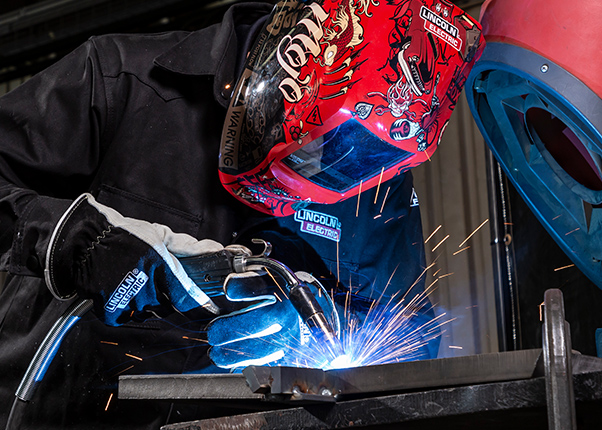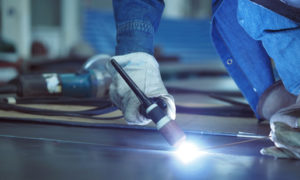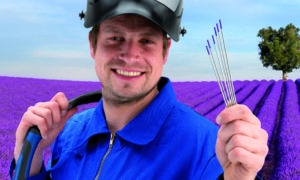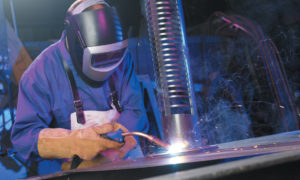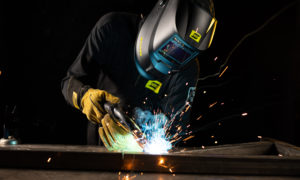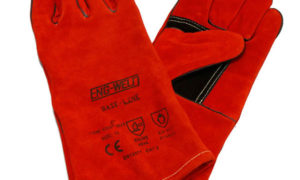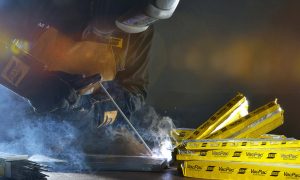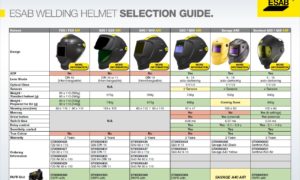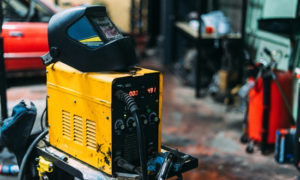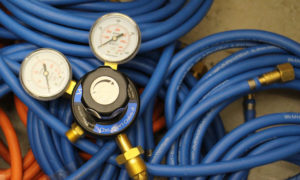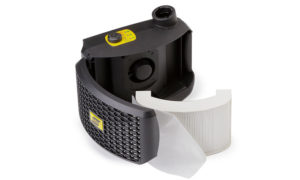Welding aluminium is challenging compared to other metals because of its characteristics such as oxidation, softness, porousness, and susceptibility to contamination. However, with the right knowledge, equipment and some practice, welding aluminium is a skill that can be learned.
Aluminium is a chemical element, atomic number 13 with the AI symbol on the periodic table. It is the third most common element on Earth after oxygen and silicon. Aluminium has a good strength-to-weight ratio at a reasonable cost making it popular in both domestic and industrial settings including homes, cars, airplanes, space, and many other products.
Can you weld aluminium?
Yes, aluminium can be welded. Welding aluminium can be more challenging than most other metals but with the right knowledge, equipment and practice, the skill can be developed. There are several reasons why working with aluminium can be complicated. Aluminium is soft, highly sensitive, and insulated by a tough oxidized layer which makes it difficult to weld.
Aluminium has a great affinity towards oxygen so when exposed to air it forms a protective layer of aluminium oxide. The oxide layer acts as a protective layer and provides resistance to corrosion. Pure aluminium has a melting point of 660°C while the protective aluminium oxide on top of aluminium has a melting point of 2,050°C. Due to the significantly high difference in the melting points of the 2 layers in aluminium, welding aluminium is susceptible to burn-through. The solution to this problem depends on the type of welding process being used.
Another main reason why aluminium welding is hard is because aluminium in a molten state tends to absorb hydrogen when heated up and the hydrogen separates as it cools which can create bubbles in the metal causing porosity and weakening the metal. Aluminium is also prone to contamination by air or from surrounding particles, resulting in inferior weld.
Factors to consider when welding aluminium
Cleanliness: regardless of what material you are welding, it is important to clean the surface of the workpiece and remove any dirt, grease, and oil that may be present. Cleaning is even more important when welding aluminium because aluminium is very susceptible to contamination.
Removing the oxide: once the workpiece has been cleaned then you should remove the oxide aluminium layer using a brush or a fleece. You can clean it with a wire brush or chemical etching. Make sure you use the wire brush exclusively for aluminium to prevent cross-contamination. Aluminium can oxide again within minutes so you may have to remove it several times. Removing the oxide is important as it can get into the weld.
Welding processes: aluminium is commonly welded with TIG and MIG welding. The right choice will depend on the application and the requirements. Stick welding/MMA welding, flux cored welding, and submerged arc welding processes are not recommended for welding aluminium as they can result in large amounts of porosity.
Preheating: is not required for thinner aluminium but it is recommended for welding thicker sheets of aluminium to prevent cracking.
MIG Welding Aluminium
Aluminium can be welded with the MIG (Metal Inert Gas) welding process which is also known as Gas Tungsten Arc Welding (GTAW). MIG welding is a type of welding process that uses a continuous solid wire electrode heated and fed through a MIG welding torch into the weld pool shielded by an inert gas. The joint is formed by melting the two base metals together. Generally, MIG welding is the preferred method where the application requires speed and higher deposition rates.
As mentioned earlier, Aluminium is prone to porosity. If you have chosen to MIG weld aluminium, then this can be prevented by ensuring the base material and the MIG welding wire are clean and free of any moisture. You must use an excellent shielding gas such as pure argon.
Here are some of the other factors to consider when MIG welding aluminium:
MIG welding machine: make sure your MIG welder is designed for aluminium welding which requires higher amperage than other metals and a specialised wire feeding system. It is recommended to have a MIG machine with a U-groove drive roller instead of the V-groove drive roller for reliable feeding. Aluminium is very soft, and a U-groove drive roller will help prevent the risk of deformation.
MIG Torch: A MIG welding machine usually comes with a standard MIG welding torch. Make sure your MIG torch is equipped with parts that are compatible with welding aluminium. A MIG torch may have a liner made of steel which can cause contamination in aluminium welding. It is recommended that you use a special liner made of carbon PTFE which allows better lubricity. The contact tip on your MIG torch should have a larger diameter than the one used for welding other materials because aluminium is a good heat conductor and expands more than other metals.
Filler material: Aluminium comes in various alloy compositions and each alloy has distinct welding characteristics. Make sure you choose a MIG welding wire that is compatible with the type of aluminium being welded. Use a high-quality aluminium MIG wire with the right diameter for the application.
Shielding gas: pure argon gas is commonly used to MIG weld aluminium as it provides excellent protection against atmospheric contamination. You can use a gas selector tool or download a gas selector guide to help you choose the right gas for your application.
MIG welding technique: welders commonly use the push technique when MIG weld aluminium. The push welding technique involves directing the torch away from the weld pool. It helps reduce the chances of burn-through and improves weld penetration. It is also important to maintain a constant speed during welding aluminium. Welding slowly may cause excessive heat input which may result in burn-through as aluminium has high thermal conductivity. Welding too slowly may result in incomplete fusion.
You can read more on Aluminium MIG welding – click here.
TIG Welding Aluminium
You can weld aluminium with TIG (Tungsten Inert Gas) welding process. TIG, also known as Gas Tungsten Arc Welding (GTAW), is a type of welding process that uses a non-consumable tungsten electrode that delivers the current to the welding arc. The tungsten and the weld pool are protected by an inert gas. TIG welding process is the preferred option where the application requires precision and clean results.
One of the benefits of TIG welding aluminium is that it uses alternating current (AC) which cleans the oxidised layer off the aluminium as it welds.
Here are the factors to consider when TIG welding aluminium:
TIG Welding Machine: TIG welders can be DC (Direct Current) only or both AC (Alternating Current) and DC, known as AC/DC TIG welders. Most aluminium welding applications require AC so you must have an AC/DC TIG welder.
Filler metals: Aluminium TIG welding rods such as ER4043 or ER53356 are used for welding aluminium. The right choice will depend on the application and the desired characteristics.
Tungsten Electrode: TIG welding process uses tungsten electrodes which create the arc between the electrode and the workpiece, enabling the welding process. For TIG welding aluminium, a tungsten electrode with a pure or alloyed composition is used. An undoped tungsten electrode made of pure tungsten will ensure good arc stability. However, the right choice will depend on the application.
Shielding Gas: pure argon gas is the most common shielding gas used to TIG weld aluminium as it provides great protection from atmospheric contamination. You can use a gas selector toolor download a gas selector guide to help you choose the right gas for your application.
TIG welders for aluminium welding
- Parweld XTT212P 200A
- Migatronic Focus 200A
- Esab Caddy TIG TA34 DC
- Lincoln Electric Aspect 200A
- Parweld 350A
- Migatronic PI250 L-TIG
- Lincoln Electric Aspect 200A Water-cooled
- Migatronic PI250 Watercooled
- Lincoln Electric Aspect 300A
- Lincoln Electric Aspect 300A Water-cooled
- Migatronic Pi350 4m / Migatronic Pi350 8m
You can read more on things to consider when TIG welding aluminium – click here.
Safety precautions
Safety is important when welding. Make sure you have appropriate personal protective equipment (PPE) to protect yourself from potential hazards. Here are some recommended PPE when welding aluminium:
Welding fume extraction system: an appropriate welding fume extraction system is important for welding aluminium to protect yourself and the people within the vicinity of the welding area from toxic welding fumes. Welding fumes may contain hazardous substances including aluminium oxide particles and other metal fumes which can cause serious health issues.
Air Fed Welding Helmet: you will need an Air Fed Welding Helmet which is essentially a welding helmet equipped with powered air purifying respirator (PAPR) to protect your eyes and to avoid inhaling harmful welding fumes and gasses. A PAPR system is essential when welding in areas with poor ventilation.
Welding gloves: welding aluminium involves extremely high temperatures so make sure you have appropriate welding gloves. MIG gloves for MIG welding and TIG gloves for tig welding to protect your hands from sparks and molten metal.
Welding jacket & trousers: make sure you have a fire-resistant welding jacket and welding trousers to protect yourself from potential burns.
If you want to learn about welding stainless steel, then please check out our guide for welding stainless steel.
If you have any questions or queries regarding welding aluminium, stainless steel or any other application then please contact us and speak to one of our experts.

